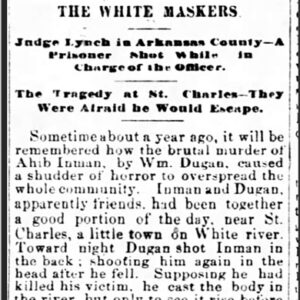calsfoundation@cals.org
William Dugan (Lynching of)
A white man named William Dugan was lynched in St. Charles (Arkansas County) on October 17, 1875, shortly after the Arkansas Supreme Court granted him a new trial for a murder he had allegedly perpetrated the previous year.
In the fall of 1874, William Dugan was arrested on a charge of having murdered Ahib Inman near St. Charles. There is a William Dugan recorded as residing in Pine Bluff (Jefferson County) on the 1870 census, where he is listed as twenty-two years old, a native of Ireland, and working as a store clerk.
According to an October 21, 1875, article in the Arkansas Gazette, the two men had apparently quarreled a few months previously, and “Inman had eloped with and married Dugan’s adopted daughter, which so incensed the man, that he resolved to take the life of the girl’s husband.” Apparently disguising his intention, Dugan spent time with Inman in St. Charles one day, but toward night, Dugan shot the man twice, first in the back and then in the head. The Gazette, in a particularly lurid fashion, added, “Supposing he had killed his victim, he cast the body in the river, but only to see it rise before his eyes like an avenging spirit. He secured the corpse, cut open the body and head, tied a plow to the remains and sunk it to the bottom.” A man named Clark had seen the pair together during the day, and when Inman was found missing, suspicions were directed toward Dugan, who was arrested for the crime.
Dugan was convicted of the murder during the March 1875 term of the Arkansas County circuit court. An April 15, 1875, report in the Gazette noted that he was sentenced to be hanged on June 11 of that year. However, the Arkansas Supreme Court, on appeal, determined that the crime had actually been committed in neighboring Monroe County, meaning that the circuit court in Arkansas County had lacked jurisdiction to hear the case.
On Saturday, October 16, Deputy Sheriff J. M. Gunnell and guard Samuel McCarty (or McCarthy) set out with Dugan, who was to be transferred to Monroe County, and “a negro prisoner named Grant Carrinton,” who had been convicted of murder and sentenced to serve time at the state penitentiary in Little Rock (Pulaski County). The Gazette reported that the men were staying the night at a hotel in St. Charles when “a posse of lynchers,” numbering twenty-two, broke open the door to their room. The report noted that two of the men guarded the officers, while five “formed a line in front of Dugan, with drawn revolvers, and at a given signal fired in a volley, killing the praying murderer instantly.”
(Various newspaper reports have this crime occurring “on the night of the 17th,” raising the question of whether the morning hours were meant, or if the party of lawmen for some reason stayed in St. Charles an extra night.)
The newspaper reported that all of the men, “except the leaders, wore masks of striped cloth, disguised by triangular pieces of white cloth over their faces.” Gunnell and McCarty themselves, “although satisfied the lynchers were citizens of the county, found it utterly impossible to recognize a single man.”
For additional information:
“Noted Criminals.” Arkansas Gazette, April 15, 1875, p. 4.
“Telegraphic Notes.” Southern Standard, October 30, 1875, p. 2.
“The White Maskers.” Arkansas Gazette, October 21, 1875, p. 1.
Staff of the CALS Encyclopedia of Arkansas
 Law
Law Post-Reconstruction through the Gilded Age, 1875 through 1900
Post-Reconstruction through the Gilded Age, 1875 through 1900 William Dugan Lynching Article
William Dugan Lynching Article 




Comments
No comments on this entry yet.